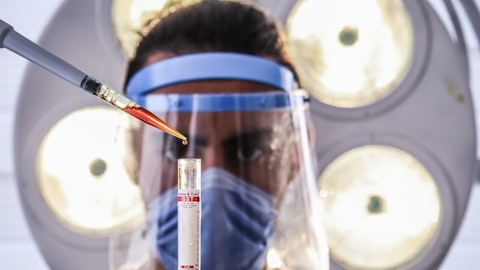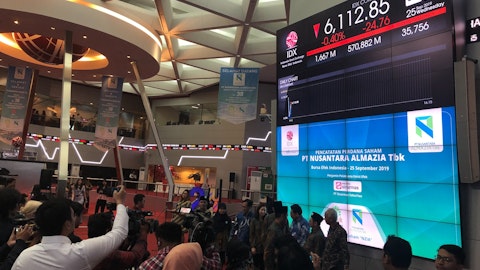GlycoMimetics, Inc. (NASDAQ:GLYC) Q3 2023 Earnings Call Transcript November 3, 2023
GlycoMimetics, Inc. reports earnings inline with expectations. Reported EPS is $-0.14 EPS, expectations were $-0.14.
Operator: Good morning, and thank you for joining the GlycoMimetics Q3 2023 Earnings Call. At this time, all participants are in a listen-only mode. Following management’s remarks, we will hold a question-and-answer session. [Operator Instructions] I would now like to turn the call over to Christian Dinneen-Long, Company Counsel at GlycoMimetics. Please go ahead.
Christian Dinneen-Long: Good morning. Today, we will review our business updates and financial results for the quarter ended September 30, 2023. The press release issued this morning is available on the company’s website at glycomimetics.com. This call is being recorded. A dial-in phone replay will be available for 24 hours after the close of the call. The webcast replay will also be available for 30-days in the Investors section of the company’s website. Joining me on the call today from GlycoMimetics are Harout Semerjian, Chief Executive Officer; Brian Hahn, Chief Financial Officer; and Dr. Edwin Rock, Chief Medical Officer. Today’s call will include forward-looking statements based on our current expectations. Forward-looking statements may include, but are not limited to, statements about the company’s product candidates, uproleselan and GMI-1687 along with statements about the progress and timing of clinical trials being conducted by us or our collaborators, planned or potential regulatory agency interactions or submissions, development plans and activities, prelaunch preparations, the company’s cash position and runway and our expectations regarding data readouts from clinical trials.
Such statements represent management’s judgment and intention as of today and involve assumptions, risks and uncertainties. GlycoMimetics undertakes no obligation to update or revise any forward-looking statement. For information concerning the risk factors that could affect the company, please refer to our filings with the SEC, which are available from the SEC or through the GlycoMimetics website. I’ll now turn the call over to Harout.
Harout Semerjian: Thank you, Christian, and good morning, everyone. In the third quarter, we continued to make strong progress advancing our clinical pipeline as we evolve into a commercial stage organization. We remain committed to executing on our vision to deliver uproleselan to AML patients in need of new treatment options, while we leverage our unique glycobiology approach to develop innovative medicines in additional diseases such as sickle cell. Today, I would like to highlight three drivers that position us well to advance these programs in the coming year. First, we continue to expect top line results from our pivotal Phase III study of uproleselan in relapsed and refractory AML by the end of Q2 2024 and remain encouraged about the unprecedented median follow-up time.
Should trial results be positive, we expect U.S. filing by end of 2024. Second, as part of our ongoing commitment to evaluate utility of uproleselan across AML, researchers from MD Anderson will present updated clinical data from their investigator-initiated trial in treated secondary AML at the American Society of Hematology meeting this December. Lastly, for GMI-1687 and our sickle cell disease program, the Phase Ia study remains on track for safety data by the end of Q1 2024. With addition of the time-based analysis option to our pivotal Phase III study of uproleselan in relapsed and refractory AML, we expect to report top line results by the end of Q2 2024. We look forward to unveiling these data at this important milestone for patients, investigators and the company.
While recently FDA-approved drugs have shown encouraging results in limited AML subpopulations, we’re optimistic that uproleselan has the potential to improve patient outcomes irrespective of mutation profile, cytogenetic risk or treatment backbone. Building on the promise of uproleselan in relapsed and refractory AML, we are excited to explore its broader potential across different age groups and disease settings through studies run by partners and independent investigators. For example, at the upcoming ASH Annual Meeting in San Diego, researchers from the MD Anderson Cancer Center will present updated clinical data from their Phase Ib/II study evaluating uproleselan run with cladribine and low-dose cytarabine in treated secondary AML patients.
We are grateful to be collaborating with leading organizations, including MD Anderson, the National Cancer Institute and the Dana Farber Cancer Institute. The commitment of our partners underscores uproleselan’s potential to improve and prolong lives for a broad spectrum of AML patients. We look forward to providing updates as these investigator-initiated clinical trials continue. Finally, we expect to announce safety data from our Phase Ia study of GMI-1687 by end of Q1 2024. We expect these data will advance us towards our aspiration to develop GMI-1687 as a patient-controlled point-of-care therapy to interrupt early sickle cell pain crisis before need to seek emergency care, we will evaluate next steps shortly thereafter. As our clinical pipeline has progressed, we have strategically expanded our commercial and medical affairs capabilities, and we are now executing critical prelaunch activities ahead of top line uproleselan readouts expected in Q2 2024.
Our educational disease awareness activities target academic and community hematologists that care for AML patients. Recently, we welcomed Dr. Gaetano Bonifacio as our Vice President of Global Medical Affairs; and Debora Peralta as our Vice President of Commercial Operations. Gaetano and Deborah brings decades of hematology launch experience and we are pleased to have the opportunity to leverage their expertise during this transformative point in our company’s evolution. Now turning to our finances. We have a cash runway to fund operations into late Q4 2024, allowing us to continue executing our clinical development plan. On today’s call, I’m happy to be joined by our CFO, Brian Hahn; and our CMO, Dr. Ed Rock. I’ll now pass it over to Ed to share more details on our ongoing trials.
Edwin Rock: Thanks, Harout. And thanks to all of you on the line for joining our call today. As Harout mentioned, we expect to report top line results of our Phase III trial by the end of Q2 2024. At that time, we’ll have a clinically mature data set for time-based primary analysis of overall survival if the 295 survival events that trigger primary analysis are not already reached by that time. Median follow-up for our Phase III trial of uproleselan in relapsed and refractory AML stands now at 33-months and will be greater than three years at time of primary analysis, that’s unprecedented for a therapeutic trial in relapsed and refractory AML. Also, a substantial majority of surviving study patients received hematopoietic cell transplantation and a primary analysis, a large majority of them will be at least two years out from their transplant.
After two years post-transplant, disease relapse becomes infrequent. So with at least two years of post-transplant follow-up for almost all transplant recipients, we’re confident that our time-based primary analysis will provide adequate trial duration to demonstrate uproleselan benefit if present. Our biologic hypothesis is that adjunctive uproleselan will lead to deeper, more durable AML disease responses that help more people to and through potentially curative hematopoietic cell transplantation. This effect may occur irrespective of specific gene mutations cytogenetic risk or treatment backbone. Correspondingly, uproleselan clinical activity is seen in both newly diagnosed and relapsed and refractory AML. Importantly, uproleselan appears to generate a notably unremarkable safety profile, adding no additional toxicity when combined with other therapies.

A biochemist observing cell cultures under a microscope, representing the groundbreaking research of the biotechnology company.
So we are optimistic that uproleselan may one day be safely combined with diverse other therapies that are broadly useful for most or all AML patients. Partner and independent investigator studies are further exploring potential benefit of uproleselan across AML subtypes. Most importantly, a randomized NCI Phase II/III trial conducted by the Alliance for Clinical Trials in Oncology is evaluating uproleselan in newly diagnosed older patients with AML who are fit for intensive chemotherapy. This trial completed Phase II randomization of 267 patients in December 2021. Phase II analysis of event-free survival has been pending since then, now almost two years since enrollment completion. And NCI recently confirmed to us that the event trigger for analysis hasn’t yet been reached.
For reference, the Phase II portion of this trial was designed to demonstrate prolongation of median event-free survival from seven to 11 months. We look forward to learning Phase II results when available. Significantly, NCI expanded our collaboration and now also supports a children’s oncology group Phase I study conducted by their Pediatric Early Phase Clinical Trial Network. This dose escalation trial will assess safety, pharmacokinetics and preliminary clinical activity of uproleselan plus chemotherapy in pediatric patients with relapsed or refractory AML. We’re glad to announce that the first patient enrolled to this study in October. Another investigator-initiated trial led by Dr. John Horan from the Dana Farber Cancer Institute and Boston Children’s Hospital also dosed its first patient earlier this year.
Dr. Horan’s trial is evaluating uproleselan with a pre-transplant regimen for pediatric and adult AML patients up to 39-years old. Today, we announced that at ASH in December, researchers from MD Anderson Cancer Center will present updated trial data on uproleselan in treated secondary AML. This rare, very high-risk study population is defined by prior chemotherapy treatment of an antecedent hematologic disorder. Prognosis is abysmal with expected median survival of less than five months. In the trial at MD Anderson, investigators sought to generate a safe approach to marrow blast reduction, disease control and potential for transplant by combining uproleselan with low-intensity chemotherapy of cladribine and cytarabine. Banned prognostic features in the study population include adverse cytogenetic risk and prior hypomethylating agent use in all evaluable patients and prior hematopoietic cell transplantation in 25% of them.
Among 18 evaluable patients as of data cutoff, there were minimal therapy-related toxicities, 72% showed a reduction in bone marrow blasts and one patient had a potentially curative transplant. These results in this notoriously difficult to treat disease underscore broad potential utility of uproleselan across the AML spectrum. In addition, researchers from Washington University will present at ASH safety and signal generating data from their trial of uproleselan to reduce GI toxicities of melphalan chemotherapy given before transplant for multiple myeloma. Beyond uproleselan, we also made progress in our Phase Ia single ascending dose trial of GMI-1687, a second-generation E-selectin antagonist. We will evaluate GMI-1687 as a potential outpatient, self-administered subcutaneous therapy to interrupt sickle cell vaso-occlusive crises.
E-selectin plays a key mechanistic role in early progression of such acutely painful pathologic events. And if successful, GMI-1687 offers potential for a point of care patient-controlled treatment option at time of pain onset. In addition to patient benefit from pain control, such a point of care therapy has potential to reduce emergency room visits and hospitalizations of recipients. As mentioned, we expect to have safety data in hand from this healthy volunteer study by the end of Q1 2024. Now I’ll turn it over to Brian for a review of financial results.
Brian Hahn: Thank you, Ed. As of September 30, 2023, GlycoMimetics had cash and cash equivalents of $49.4 million, as compared to $47.9 million as of December 31, 2022. This increase was due to the company’s ability to raise additional cash earlier this year. The company’s research and development expenses were $5.3 million for the quarter ended September 30, 2023, as compared to $4.9 million for the same period in 2022. The increased expenses were primarily due to the clinical development costs related to the Phase Ia trial of GMI-1687 in healthy adult volunteers, which was initiated in August 2023 partially offset by decreased personnel-related and stock-based compensation costs due to lower head count. The company’s general and administrative expenses increased to $4.5 million for the quarter ended September 30, 2023, as compared to $3.8 million for the same period in 2022.
Increased expenses were primarily due to higher personnel-related expenses and higher professional fees as the company advances uproleselan and prepare us for potential regulatory filing and commercialization. I’d now like to turn the call back to Harout.
Harout Semerjian: Thank you, Brian. In summary, we are at a crucial stage in our company’s evolution. In the coming months, we will remain laser-focused on delivering the data, our Phase III study of uproleselan in relapsed and refractory AML. And continuing strategic prelaunch activities to accelerate our transition to a commercial stage company after top line results by end of Q2 2024. We have the right team with the right experience in place. And I’m confident that we will be able to build upon our collective track record of successful commercial launches should data permit. Also, we continue to explore uproleselan’s potential across the AML spectrum, thanks to studies conducted by institutions such as the NCI, Dana-Farber Cancer Institute and MD Anderson Cancer Center.
Finally, we continue to progress our Phase I study of GMI-1687 towards initial data readout in Q1 2024. In closing, I want to thank our employees whose hard work and dedication drive uproleselan forward as well as the patients and investigators that make these trials possible. I’d now like to open the lines to Q&A. Operator?
Operator: [Operator Instructions] Our first question will be coming from Roger Song of Jefferies. Roger, your line is open.
See also 25 Countries With The Worst Healthcare System and Top 15 Universities for Learning Crypto and Blockchain Technology.
Q&A Session
Follow Glycomimetics Inc (NASDAQ:GLYC)
Follow Glycomimetics Inc (NASDAQ:GLYC)
Roger Song: Great, thank you. Thanks for the update. A couple of questions from us. One thing is, can you share with us how likely by the end of 2Q 2024, you — the primary analysis will be event based versus the time based? Just in other words, how the event accumulation since last update?
Harout Semerjian: Excellent question. So as we have mentioned over the last year, we have seen at two stages a slowdown in the number of events, which really led us to the collaboration with the FDA and the introduction of the time-based event trigger. So currently, we are monitoring this very carefully, Roger. And what’s happening is a lot of the patients as we are now almost two years out from full enrollment, the follow-up, a lot of the times goes into quarterly rather than monthly. So we’re evaluating that over the next couple of months, and we should know better by end of year and beyond. But currently, what we are very pleased about is either through the event-based trigger or the time-based trigger, we have a definitive cutoff by end of Q2 2024.
Roger Song: Excellent. I look forward to the next update. And also you guided you will submit NDA by the end of this year, by the end of 2024, if the primary analysis is positive. Just curious, any outstanding CMC or preclinical work, you still need to finish before you can file the NDA or anything else, the steps into the NDA filing?
Harout Semerjian: Yes. Roger, we’re in a very good shape as we have been really — this trial, as you know, has taken longer than what any of us have anticipated driven by the fact that patients continue to live longer. Meanwhile, we have done a very good job in terms of advancing CMC conversations, making sure that we have drug, making sure that we’re preparing for an NDA filing with whatever we can do before we actually see the data as we continue to be blinded to that. So we think we have the foundation for a very rapid move into an NDA filing after the data, should the data be positive. So that’s why we are now in a position to say that we’re going to be doing that before end of the year.
Roger Song: Excellent. Yes, you do have some additional time to prepare all the work, okay. Maybe just last one from us, if I can is, in terms of 1687, the healthy volunteer data by the end of 1Q next year. So how should we think about that data? What are you really looking for from the data to move forward like the dose response or biomarker? That would be helpful. Thank you.
Harout Semerjian: Yes. Maybe I’ll tackle some of the strategic perspective. And Ed, if you want to add a few things about what we’re going to be seeing. So strategically, Roger, as you know, 1687 is our second-generation E-selectin antagonist that is subcutaneously bioavailable. And that’s why we’re very excited to target sickle cell disease as our next area. As you know, we have a very deep tradition in that area with our first-generation molecule. So once we see — of course, the Phase Ia is really about safety. We want to make sure that we are doing all the building blocks to get to the next level. And depending on the data and depending on where we are as well with not just the 301, our company-sponsored trial, but also the NCI-sponsored Phase II in the frontline setting, which continues to also take longer, depending on what happens with these, we will be in a situation to say what do we want to do next and when after that.
But Ed, if you want to maybe tackle what’s the Phase Ia.
Edwin Rock: Sure. Roger, as you know, key information from any first-in-human trial will include safety data and pharmacokinetics, in particular, will the pharmacokinetics support achievement of a potential therapeutic level of the study drug. Based on prior GlycoMimetics experience, we’re confident that GMI-1687 will perform, and we’ll demonstrate that and share it when available.
Roger Song: Awesome. That’s great. Thanks for taking the question. That’s it from the line.
Harout Semerjian: Thank you, Roger.
Operator: [Operator Instructions] Our next question will be coming from Boris Peaker of TD Cowen. Your line is open.




